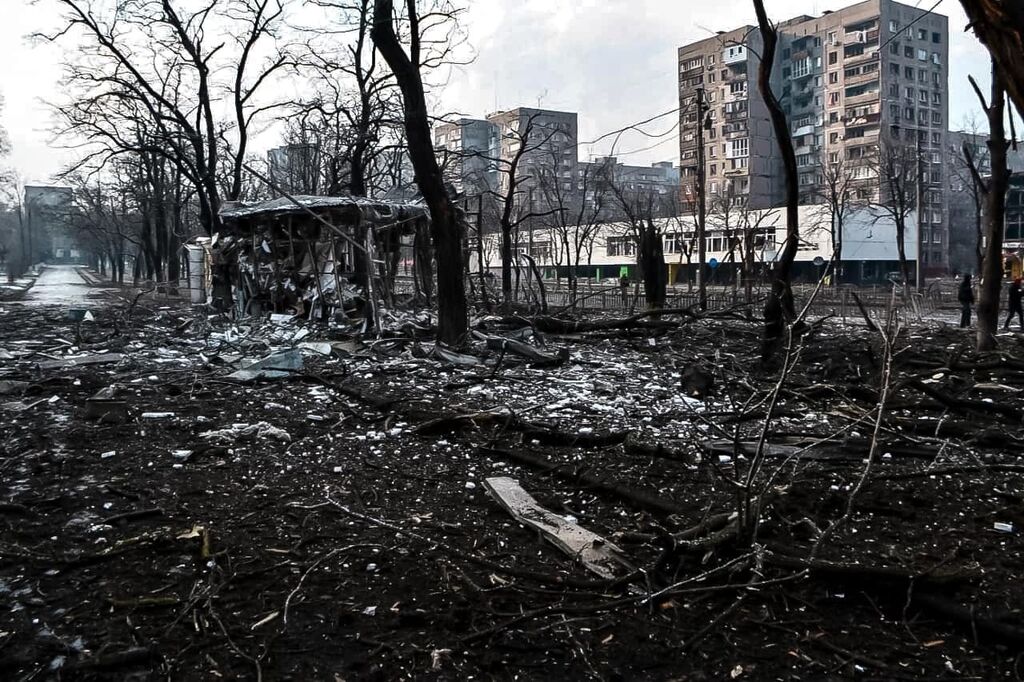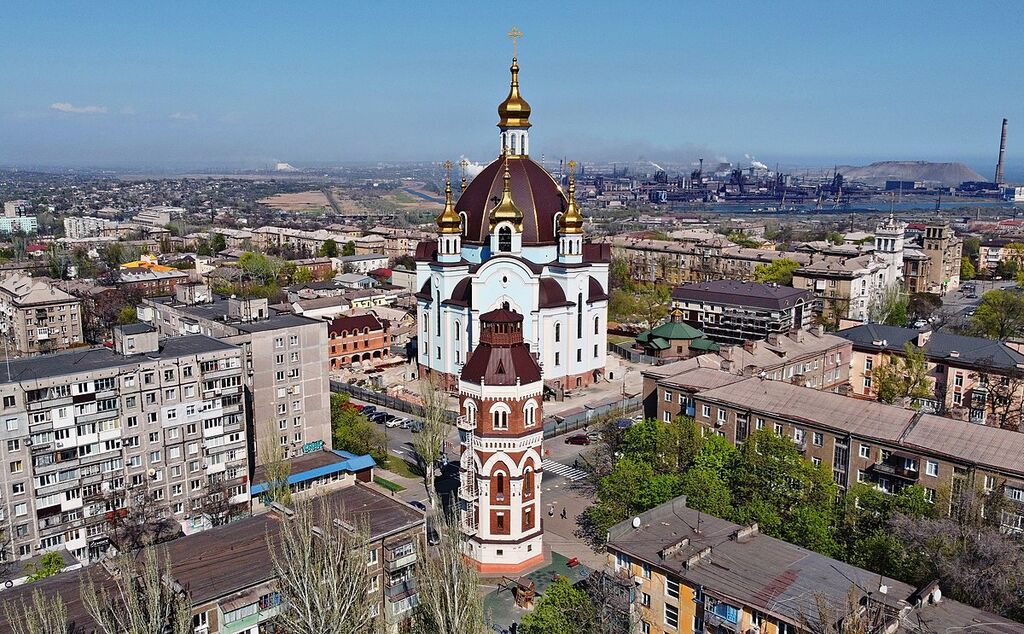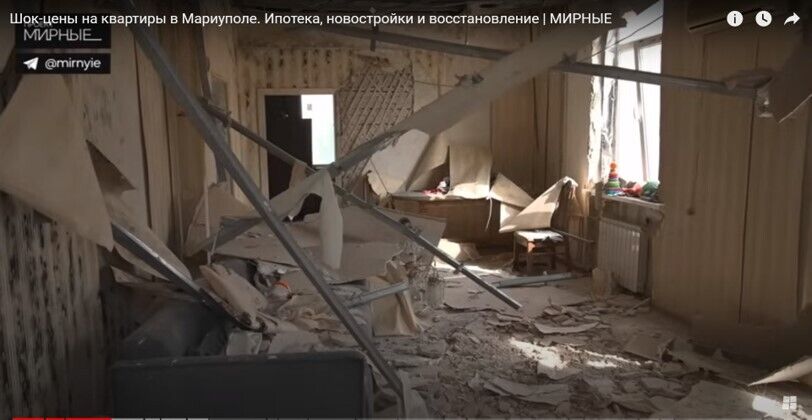During a nearly three-month-long Russian siege of Mariupol the city has been almost completely damaged and huge parts have been literally destroyed. Although occupying authorities promised residents new houses, officials are threatening to evict apartment owners whose documents were lost in the chaos of street fighting. Entire districts are being demolished to make way for sea-view apartments which are too expensive for former residents, writes Alla Konstantinova in an article for independent Russian news outlet Mediazona.
 Mariupol during the siege. Photo: Wikipedia
Mariupol during the siege. Photo: Wikipedia
By Alla Konstantinova
Oksana, along with her husband and child, left Mariupol for Dnipro on March 16, 2022. Before the Russian invasion, she lived in the Primorsky District and had converted the basement of her five-storey building into a beauty salon. It was in this same basement that Oksana and her family hid from bombardments for three weeks, she told Mediazona.
‘On the hill, near the administration building, overlooking the sea, stands our five-storey building,' she recalls. 'Every house around ours was destroyed, totally riddled with bullet holes. Our building miraculously suffered only minor damage—well, the windows were blown out, of course.’
Last year, after Oksana had moved to Vilnius, Lithuania, the occupying authorities in Mariupol inspected her vacant apartment. A neighbour, who had the keys, opened the door. When leaving, the Ukrainian family took property documents with them, but returning to Mariupol is now impossible. In November 2023, when Oksana tried to reach her hometown via Estonia and Russia, Russian border guards in Ivangorod denied her entry, she says. ‘They didn’t have to explain why, they just mentioned I had "an undesirable contact,"' she recalls.
The main objective of that unsuccessful journey wasn’t the abandoned apartment, but Oksana’s mother, whom they hadn’t seen since the war began. Oksana hoped to evacuate her and her grandmother from Mariupol.
‘Her house is just a 15-minute walk from ours, but during the bombardments, it was impossible to move around: we only managed to get as far as three houses away before having to throw ourselves to the ground,’ she explains. ‘For six months after leaving for Dnipro, we had no idea if she was alive, there was no way to communicate. We looked for information on both Ukrainian and Russian Telegram channels, I scoured internet videos searching for her house. Then some acquaintances from Horlivka visited Mariupol and went straight to her house, they found her. They gave her a card, a local number. Several months later, a weak internet connection appeared—it’s still poor—and we can only correspond via Telegram.’
In the spring of 2022, Oksana's mother was wounded in her own home, which is ‘still riddled with holes,’ says the Ukrainian. ‘It’s all shot up, leaking. But she still lives there.’
Confiscation
Oksana is convinced that her seaside apartment will now surely be 'nationalised,' meaning confiscated. There’s an ongoing so-called 'comprehensive inventorying' in the city. The occupying city administration announced its start at the end of October, although the Russians began cataloguing apartments and houses in Mariupol, including those destroyed, last year.
'Inventorying commissions' have been established to reassess real estate properties, tasked with conducting 'visual and functional inspections' of apartments and private homes in Mariupol. During these inspections, the commission members must determine whether the properties have owners. If the owners do not present the occupying authorities with property documents within 30 days, they 'will lose the right to use such residential premises' according to a decree.
In January, Ukrainian politician Petro Andryushchenko published a list of houses slated for demolition, noting that the document was 'not public', so searching for it on the 'websites of the gauleiters' was pointless. Meanwhile, Mariupol residents, already deprived of their homes, are protesting, demanding the promised apartments.
According to an apartment owner in one of the destroyed buildings, the city authorities approved her application for new housing in March, but abruptly cancelled their decision six months later. ‘On August 3, 2023, I received a message that our local authorities had changed their minds and decided that I have no right to housing at all,’ she says. ‘So, for six months, my husband and I have been wandering the city streets, while apartments in my building are being sold. It’s too good a location. They decided to make money on our misery, and they stole our house from us. Nobody hears us, nobody wants to listen. We are appealing directly to Russia. Please, hear us, return our home to us.'
Sister city relationship with St. Petersburg
Russian authorities first announced plans to rebuild Mariupol on March 24, 2022, amidst intense urban combat. ‘Russia will rebuild everything. First, we must conclude the operation. Then, builders and everyone will pile in and get it done. Everything will be restored,’ promised Andrey Turchak, the First Deputy Speaker of the Federation Council, at the time.
On June 1, 2022, the Governor of St. Petersburg, Alexander Beglov, signed a twinning agreement with Konstantin Ivashchenko, the former head of Mariupol’s occupational administration. Beglov announced that Pobeda, a foundation established in 1999 and previously focused on military-patriotic education of teenagers rather than construction, would assist in the city’s reconstruction.
Beglov also promised that a thousand St. Petersburg residents would travel to work on Mariupol’s construction sites. In April 2023, the foundation disclosed for the first time part of its expenditure on the Ukrainian city under occupation: 880 million rubles out of the 11.8 billion (or $10 million out of $132 million) already raised for 'reconstruction.' The specific projects funded were not disclosed.
Independent Russian news outlet Bumaga learned that the Pobeda foundation receives funds from St. Petersburg’s reserve fund, which is formed from the city’s budget and approved by the St. Petersburg administration. According to Bumaga, at least 25 St. Petersburg organizations are working on construction sites in Mariupol.
 Mariupol before the siege. Photo from Wikipedia
Mariupol before the siege. Photo from Wikipedia
Map of vanishing houses
Since the autumn of 2022, users have noticed that symbols representing buildings destroyed during Mariupol’s siege and assault are disappearing from the Yandex Maps service. This issue was highlighted by Ukraine’s Human Rights Ombudsman, Dmitry Lubinets.
Despite this, these destroyed buildings remain marked on an alternative map, diligently compiled since the onset of the Russian incursion into Ukraine by Vitaliy Shtutman, an SMM professional from Israel. Continuously updated, the map’s accuracy is enhanced by Mariupol residents themselves, who assist in pinpointing the exact locations of the destroyed houses.
‘Currently, my map shows two thousand residential buildings,’ Vitaliy Shtutman tells Mediazona. ‘But it's not just demolished ones; there are also damaged and destroyed buildings.’
In October 2022, the State Institute for Spatial Planning, commissioned by Russia’s Ministry of Construction, developed a plan for Mariupol’s reconstruction up to 2035, which was obtained by The Village. According to the plan’s forecast, Mariupol’s population is expected to increase from 212,000 to 350,000 by 2025. The plan’s 'Immediate Tasks' section begins with 'the restoration of individual housing construction and the rapid construction of multi-storey buildings.' Next in line is urban infrastructure and 'the preservation and restoration of natural areas.'
Among the buildings promised to be rebuilt is the drama theatre, where, due to a Russian airstrike on March 16, 2022, from 12 to 600 civilians were reportedly killed. The exact number of casualties remains unknown: access to the building was initially hindered by street fighting, and later Mariupol was occupied by Russian troops. Deputy Prime Minister for Construction and Regional Development Marat Khusnullin claimed the theatre would be restored by the end of 2024.
All construction work in Mariupol is overseen by Unified Customer in the Construction Sector, a state company. In 2022, the assets of the company increased by 182%, reaching 225 billion rubles, or $2.5 billion, as discovered by Bumaga. Despite the organization not reporting its expenses, its connection to the occupied territories can be traced on Goszakupki, the government procurement service: in April 2023, UCCS leased several minivans and crossovers for 56.4 million rubles, listing the service areas as 'DPR, LPR, Zaporizhzhia, and Kherson regions.'
In December 2023, the company announced an increase in the number of builders working with 'complex houses' from 2,500 to 5,000. In total, according to the UCCS, 20,000 builders from all regions of Russia converged on Mariupol.
More than 10,000 graves
In December 2022, the Associated Press counted at least 10,300 graves in occupied Mariupol on satellite images, which appeared in the city since the beginning of the Russian invasion.
Vitaliy Shtutman’s map marks more than 400 graves and death sites with crowdsourced photographs. Many of these are located in the courtyards of houses where construction is now taking place, and it is often unknown whether human remains were reburied in cemeteries before the work began.
Shtutman told Mediazona that he began collecting evidence of destruction in Mariupol in the spring of 2022 for personal reasons. ‘Some asked why I was doing this and who I was working for. I replied: 'I just want my friends and relatives in Moscow to see it too.' The only thing is—they don’t want to look at it, but I’m doing what I can,’ he said.
 On YouTube one can find several 'room tours' of destroyed homes, filmed by the propaganda channel Mirnye. Schreenshot YouTube
On YouTube one can find several 'room tours' of destroyed homes, filmed by the propaganda channel Mirnye. Schreenshot YouTube
No priority for remaining Mariupol residents
To obtain new housing, Mariupol residents who lost their homes must provide the occupational city administration with documents for their lost property, as stated in the decree 'On the Regulation of Property Issues for Replenishing the Maneuvering Fund of the City of Mariupol.'
But many in the city no longer have their documents—fleeing from shelling, people ran without belongings, says Nikolai Osychenko, former head of Mariupol Television, to Mediazona. He left the city on March 15, 2022, but continues to run his Telegram channel and, according to him, maintains constant contact with his fellow citizens remaining under occupation.
‘To apply for social housing, you need documents for the home you lost,’ says Osychenko. ‘But most people lost their homes along with their documents. Under shelling, people didn’t think about running out of the house with their property deeds in hand.’
Last year, the occupational administration of Mariupol began publishing 'lists of ownerless housing,' breaking into apartments that were unoccupied, explains Osychenko. If the owner of the property does not appear at the district administration with the necessary documents within 30 days of the address appearing on such a list, it is indeed declared ownerless and 'nationalized.'
‘If last year you could still ask a neighbor to confirm that the property had an owner, now that’s no longer possible—only personal attendance or a power of attorney through a Russian notary,’ Osychenko clarifies.
However, even having papers in hand does not always guarantee new housing. Alexandra Borman, an orphan, had been on a waiting list for an apartment for 12 years. A year before the Russian invasion, Alexandra and her family moved into house number 29 on Heroichna Street and renovated it. Then the war began.
‘The day we left, a shell hit our apartment building, half of it just collapsed immediately,’ she tells Mediazona. ‘Now we are living in a suburban house in the Mirny district, heaters can’t be turned on, the stove doesn’t work. It’s +2C/35F inside, and I have two children.’
The ruins of her destroyed house withstood for a long time, says Alexandra. Meanwhile, she gathered documents: the deed, a registration certificate, and a social housing contract. In the end, she was denied new housing without explanation.
‘They told me the building was completely demolished and the site was bought for development by some private buyer. They said that since I received the apartment from the city, I’m not entitled to anything. They just issued a decision that the building is to be demolished. But at least explain to me, why am I not entitled?’
Nikolai Osychenko explains that priority for housing in Mariupol is given to officials from the occupational administration and incoming builders, while ‘resettlement of ordinary people is deemed secondary’. Some Mariupol residents were relocated to so-called maneuver housing, where they remain to this day, despite being promised it was a temporary measure.
‘There are people who are still living in basements,’ says Osychenko. ‘An acquaintance reached out to me, whose friend, along with her elderly mother, has been living in a basement for a year and a half—their house is destroyed, and they have nowhere else to go. She asked her friend how much it would cost to leave Mariupol for Ukraine. According to her, they simply won’t survive another winter in the basement with her mother.’
 Putin visited Mariupol in propaganda stunt, spring 2023. Photo: Kremlin.ru
Putin visited Mariupol in propaganda stunt, spring 2023. Photo: Kremlin.ru
Selective 'reconstruction'
Occupational authorities are primarily rebuilding the center of Mariupol and the districts at the entrance to the city from the Donetsk and Zaporizhzhia sides, and this is not accidental, says Osychenko.
‘Theoretically, these are the directions of counter-offensive—they are shielded by residential areas,’ he explains. ‘But if you pay attention to Russian media, there are practically no reports from the left bank. Because there, it’s a total mess, indescribably bad. The left bank is closest to Russia, and it saw the most intense fighting, where Russia entered. Therefore, almost everything there is destroyed.’
Oleg, a Mariupol city council deputy who did not collaborate with the new authorities after the occupation, tells Mediazona that on the left bank, almost all the houses along the Morskyi Boulevard have been demolished. This spans about four kilometers along the coast, from the abandoned Orlyonok camp to the Azovstal sports complex.
‘I think there will be elite housing there, but so far, not a single house has been built on the left bank,’ he says. ‘It was an entire district of khrushchevka apartments. A few of them still stand, with inscriptions saying: 'We want to return home.'’
Meanwhile, among Russians, there is a growing demand for property in Mariupol: Independent Russian local media outlet Bumaga found that the first advertisements from potential buyers began appearing on VK social network on May 3, 2022, when fighting was still ongoing in the city. On YouTube, meanwhile, one can find several 'room tours' of destroyed homes, filmed by the propaganda channel called Mirnye, or The Peaceful.
‘A splendid view opens from the balcony. Let’s go, I’ll show you,’ says a realtor named Natalia in one such video, diverting her gaze from a collapsed ceiling and navigating through the debris of furniture in a damaged apartment.
Oleg notes that the remaining homeless residents of Mariupol are increasingly expressing their dissatisfaction.
‘Imagine demolishing an entire district and then giving the people nothing,’ he says.
Oleg cites the landmark Clock House, destroyed in March 2022 and later demolished, as an example. In July, the city authorities announced the start of apartment sales in the newly rebuilt Clock House. According to local publications, a one-bedroom apartment in the yet-to-be-completed building is priced at 5 million rubles, and a two-bedroom at 8.5 million ($55,800 and $95,000, respectively). Oleg is certain that local residents cannot afford these prices, even with a mortgage amid job scarcity in the city.
Moreover, all apartments in the Clock House have already been sold, the office of the developer, RKS-Development, told Mediazona. According to a sales manager, housing is now only available in the adjacent nine-story building under construction, priced 'approximately at 150,000 rubles per square meter.'
‘Apartments are sold to everyone on the same terms,’ the office added. ‘As a developer, we don’t provide compensatory housing; we construct the building. The municipality handles compensatory housing.’
One of the former residents of the destroyed Clock House told Kholod that only 11 tenants received property deeds, but they have not yet been provided with new housing. They will most certainly not be allowed to move into the new Clock House.
‘Even before the new decree was adopted, when we learned that our house was being rebuilt under a mortgage, we began to demand, to write, that we needed housing in our building,’ says Maria. ‘The prosecutor’s office wonderfully responds that they requested information from the Mariupol administration and the developer, but they did not provide it, so they cannot help.’’
In March 2023, Vladimir Putin visited occupied Mariupol and toured the Nevsky new construction area. While he was talking to people in the courtyard, a woman shouted in the distance, what later people recalled as: ‘This is all false. This is all for show.’ Later, this fragment disappeared from the official footage on the Kremlin’s website. Another segment, where an elderly man tells Putin that he ‘was left with nothing at 70,’ also vanished.
‘Now we have everything,’ a neighbor quickly corrected him, nervously laughing.
This article was originally published by Mediazona
See also the recent report by Human Rights Watch 'Ukraine: New findings on Russia's Devastation of Mariupol'
